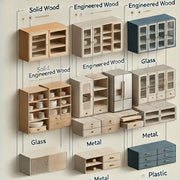
Materials Used in Crockery Almirahs
The domestic structure of Crockery almirahs serves both as proper storage technology for delicate porcelain sets and decorative advancement for interior appearance. Crockery almirah units suitable for kitchens and dining rooms and lobbies exist in multiple materials that provide distinctive characteristics. The selection of materials determines the endurance rate of the almirah while simultaneously affecting the buying price and visual attractiveness. The following section details the different materials which builders utilize for crockery almirah fabrication.
1. Wooden Crockery Almirahs
The longevity together with traditional elegance makes wood a top preference for crockery almirah construction. Traditional carving and modern sleek appearance are both possible with wooden crockery almirah designs. Crockery almirahs built from hardwood types teak oak and rosewood offer the best combination of strength and long service life. The combination of elegance with functionality characterizes wooden crockery almirah glass designs because they show items stored inside through transparent glass.
2. Metal Crockery Almirahs
Metal almirahs receive rising demand since their aluminum construction offers both weight efficiency along with durability. The price of aluminium almirah depends on its gauge thickness but features an 18 gauge almirah weight for its dependable structure. Metal almirahs receive powder-coating that extends their lifespan by countering rust formation.
3. Plastic Crockery Almirahs
Budget-oriented customers can find excellent value in plastic crockery almirah products. The almirah plastic price remains affordable compared to both wood and metal products. Plastic almirahs remain durable in humid areas such as kitchens due to their lightweight weight and their moisture-resistance property. They also enable effortless cleaning.
4. Glass Crockery Almirahs
Today's almirah glass designs for displaying crockery provide elegance to modern interior spaces. The storage cabinets incorporate tempered glass as safety and structural components in their designs. Modern crockery almirah glass designs help homeowners showcase their valuable merchandise since they enable both display and dust and damage protection.
5. MDF and Plywood Crockery Almirahs
MDF (Medium Density Fiberboard) and plywood serve as more economic choices than solid wood for almirah products. The materials deliver matching design qualities but need lower expenses to build almirahs. Modern designs of crockery almirahs use treated woods that survive termites and moisture which makes them suitable choices for modern settings.
6. Steel Crockery Almirahs
Steel almirahs represent solid choices because they provide durable security and protection. The storage units come with built-in locking systems that protect the stored items including ceramics. An almirah locker price depends heavily on the presence of additional shelves and choice of locking security features. The selection of steel almirah finishes includes matte and glossy options that allow buyers to find designs compatible with modern interior aesthetics.
Your Crockery Almirah demands the appropriate material choice.
Despite being essential to consider both budget and design preferences and space availability when buying a crockery almirah that will be placed in kitchen or dining areas. There are three types of recommendations I propose according to various needs.
The traditional option requires a wooden crockery almirah with elaborate decorative details in its craftsmanship.
A contemporary appearance demands a clean and upscale design with glass elements on the crockery almirah.
People on a budget can find suitable products in plastic or MDF almirahs which combine affordable costs with dependable longevity.
The best options for enduring durability are steel and aluminium almirah cabinets.
Latest Trends in Crockery Almirah Designs
The present-day crockery almirah designs combine fresh interior design trends through these different designs:
The strategic placement of corner crockery almirahs uses space to the maximum.
Compact home owners benefit from mini crockery almirah units.
Lobby rooms receive enhanced elegance by establishing Crockery almirah arrangements.
Conclusion








